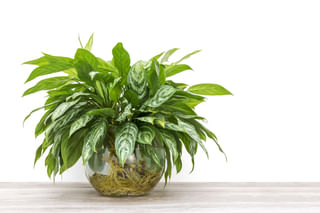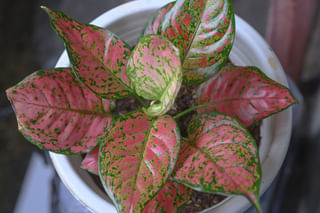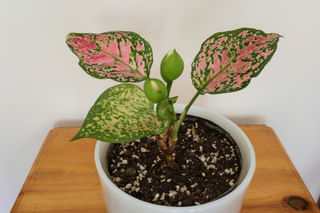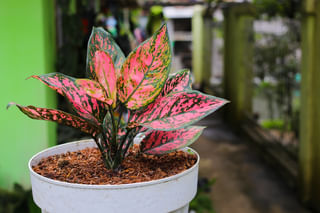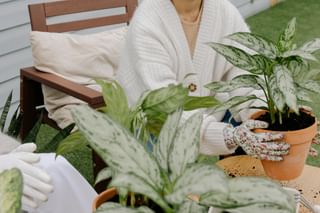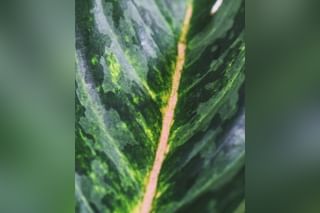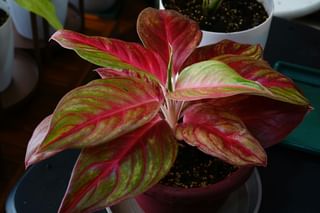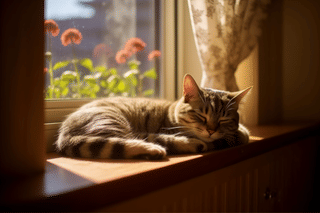How to care for an Aglaonema (Chinese Evergreen)
In this plant care guide, we'll look at tips for successfully caring for an Aglaonema (Chinese Evergreen). Learn about its ideal light requirements, how it likes to be watered, its ideal humidity levels in your house, and more. Keep your Aglaonema healthy and beautiful with this helpful guide!
Are you looking for an easy-to-care-for houseplant that can be put in the darker spaces of your house? If so, the Aglaonema, also known as the Chinese Evergreen, is the perfect plant for you!
The Chinese Evergreen comes in several incredible colors with a spotted pattern and thrives in many different types of sunlight exposure, so you won't have any trouble finding a spot that's right for your Aglaonema to grow.
In this plant care guide, we're going to look at how we can help your Aglaonema thrive in your home. We're going to look at these aspects of its plant care routine:
Let's get started and learn how we can help your Chinese Evergreen stay happy in healthy in your house!
How do you water an Aglaonema?
Watering is one of the most important parts of taking care of plants, it has a huge influence on whether your plant stays healthy or it's struggling. Luckily, the Aglaonema has fairly average watering needs: It likes to be watered regularly but also likes to dry out slightly before being watered again.
The easiest way to water this plant properly is to use a pot with drainage holes. When you're watering your plant, water until the excess moisture starts to drip out of the drainage holes. The soil will have absorbed all the moisture it can and the drainage holes help you to prevent overwatering by removing the excess water from the pot.
Before watering your plant it's important to check whether the top 2-5 cm (1-2 inches) of soil are dry to the touch. If so, you can water your plant. If not, wait a day or 2 and check again. By checking the soil before you water your plant, you help to avoid overwatering.
How often you should water your Aglaonema
On average, you should water your Aglaonema once every 7 days in the spring and summer. This schedule can be longer or shorter for you depending on the temperature and humidity levels in your house. If it's warm and dry, you'll have to water more often and if it's humid or cold, you might have to water less often.
Watering during the winter
During the winter, your plant will need less water due to cooler temperatures and lack of growth. On average, you should water your Aglaonema once every 10 days in winter. This may vary depending on humidity and temperature levels in your home.
What are the signs of over-watering or under-watering?
Everyone has overwatered or underwatered their plants before, but how do you recognize the signs your Aglaonema shows you if it hasn't been watered as it wants?
If your Aglaonema is not getting enough water, the leaves will start to curl and turn yellow or brown. The plant might also be drooping. If you notice any of these signs, immediately water your plant until the excess moisture runs out of the drainage holes.
If your Aglaonema is getting too much water, the leaves will start to turn yellow and the roots can start to rot. If you notice any of these signs, immediately stop watering your plant and check if there's standing water in the pot or tray underneath your pot. If so, empty it and wait until the top 2-5 cm (1-2 inches) of soil is dry before watering again.
What is the best light for an Aglaonema?
An Aglaonema needs indirect sunlight for the best growth but can tolerate lower light levels as well. In general, you should place your Chinese Evergreen near a bright window with some shade from direct sunlight - this could be from curtains, blinds, or even other plants.
The green and white variety of the Aglaonema can tolerate low-light spaces in your house quite well, but the colored varieties need brighter spots to keep their vibrant colors looking their best.
How do you know if the plant is getting too much or too little light?
If your Aglaonema is not getting enough light it can start to lose the variegation, the spots on its leaves will lose color and the plant might get leggy (A plant that looks stretched out). If you notice this happening, move your Aglaonema closer to a window with more sunlight.
If your Aglaonema is getting too much light, you'll see the leaves start to turn yellow or brown and dry out. If this happens, move your Aglaonema away from direct sunlight and find a spot with more indirect light for it.
The direct sunlight is too harsh for all varieties of the Aglaonema and will scorch their leaves if they're exposed to the harsh sunlight for too long, especially during the summer.
What are the ideal humidity levels for an Aglaonema?
Aglaonemas like high levels of humidity to stay healthy, around 60-70%. So if you live in a place where it's quite dry, you may have to take some steps to increase the humidity in your house or around your Chinese evergreen.
If you notice the leaves start to look dry, it could be a sign that the humidity levels are too low and you might need to increase them. You could place your plant on a tray with pebbles and water or group plants together that need similar levels of moisture: this creates a "microclimate" where the humidity is higher than in the rest of your house.
If you're using the pebble tray method, make sure your plant isn't sitting in a layer of water, but on top of the pebbles, away from the water. This could accidentally overwater your plant if your pot has drainage holes.
Another fantastic way to increase the humidity in your house, to help your plants get the humidity they need, is to use a humidifier. This is a more premium solution, but will also benefit you, not just your plants.
What is the ideal temperature range for an Aglaonema?
Aglaonemas are tropical plants, so they prefer warmer temperatures. They thrive in temperatures between 18-27 degrees Celsius (65-80 F) during the day. Temperatures lower than 18 (65); can cause the leaves to yellow and drop off, while temperatures above 27 (80); can lead to wilting. It's important to keep your Aglaonema away from hot or cold drafts, as this can damage their leaves.
You can also move your plant outside during the spring and summer, as long as you make sure that temperatures won't drop too low at night. And of course, don't forget to bring it back inside when the weather starts to cool down again.
If you do decide to move your plant outside in the spring and summer, make sure to protect it against hard winds by placing it next to a fence or a wall.
What is the best soil for an Aglaonema?
The best soil for an Aglaonema is a well-draining potting mix. This type of soil will allow for proper drainage, preventing the roots from becoming waterlogged, which can cause root rot.
You can create the perfect potting soil mix for your Aglaonema by mixing 1/3 potting soil, 1/3 peat moss, and 1/3 perlite. This mix is perfect for plants that need their soil to stay light and airy. This type of soil will drain excess moisture quickly while letting oxygen freely pass down to the roots of your plant.
The peat moss and potting soil will provide your Chinese Evergreen with a nutrient-rich growing environment so it can stay healthy in the long run.
You want the mix to stay moist but not soggy. That's where the peat moss and perlite come in. The peat moss holds onto moisture well and the perlite drains the excess moisture to the bottom of the pot quickly. This creates a nice balance for your soil.
If you're not a huge fan of fertilizing your plant regularly, this is the perfect time to add a slow-release fertilizer to your potting mix. This will ensure that your Aglaonema gets all the nutrients it needs without having to constantly re-apply liquid fertilizer every few weeks. We'll look more at how to fertilize your Chinese Evergreen in the next section.
As a final note about the soil, I'd like to mention that it's a good idea to refresh your potting mix every 2-3 years as part of regular maintenance. This helps keep your Aglaonema's soil light, which will keep your plant healthy for many years.
How do you fertilize an Aglaonema?
Fertilizing your plants helps them grow strong and healthy and provides them with the nutrients they need for growth. It's important to fertilize your Chinese Evergreen once every month during spring and summer when it's actively growing. During fall and winter, you shouldn't fertilize your Aglaonema, because it won't grow (at all) during this time of year.
The easiest way to fertilize your Aglaonema, if you're not already using a slow-release fertilizer in the soil, is to use a liquid fertilizer. You should mix this type of fertilizer with the water you use to water your plant. This dilutes the fertilizer, so you won't overfertilize your plant.
It's important to not over-fertilize your Aglaonema as this can damage its roots and cause brown tips on its leaves. Overfertilizing can also burn the plant's roots, leading to stunted growth and yellowing leaves. If you're not using liquid fertilizer to feed your plant, it's important to water your plant before and after fertilizing. This helps the fertilizer to be absorbed by your plant and the soil and helps to distribute the nutrients throughout the pot.
When and how should you prune an Aglaonema?

Pruning your Aglaonema helps to keep the plant healthy and looking its best. Usually, you only prune your plant to remove any dead or damaged leaves, so make sure to avoid pruning large amounts of foliage as this can put unnecessary stress on the Aglaonema.
The best time to prune an Aglaonema is in the spring, but you should also be on the lookout for any burnt or yellow leaves throughout the year. During this time of year, when your plant is in its growing season, it'll recover from any pruning much more quickly.
When you're pruning, make sure to use sharp, clean pruning shears or scissors and cut as close to the base of the plant as possible. This helps you to prevent too much dead foliage in the weeks after the pruning. Dead foliage attracts pests and diseases, so it's best to minimize their chances.
Finally, after pruning your Aglaonema make sure to keep an eye on its water levels for a few weeks. Don't let them get too low or too high until your plant has settled back into its routine.
How do you repot an Aglaonema?
Every 2-3 years you should refresh your Aglaonema's soil and this also happens to be the perfect time to repot your plant into a slightly larger pot. Many plant owners will use repotting their plants as the perfect excuse to refresh their soil as well, so let's see how we should repot a Chinese Evergreen.
Repotting an Aglaonema is quite easy and can be done by following these steps:
- Gently remove the plant from its current pot. If the roots are sticking to the pot, carefully loosen them with a knife or spoon.
- Carefully cut away any dead or damaged roots, while also loosening the old soil around the roots.
- Place a layer of new potting mix at the bottom of your new pot. This pot should be one size larger than the current pot, around 2-5 cm (1-2 inches) larger.
- Place your Aglaonema on top of this layer and fill up any gaps with fresh potting mix until all roots are covered.
- Give your newly potted Agloanema a thorough watering so that all air pockets can be removed from underneath its roots. Air pockets hold onto water and prevent proper drainage.
- Remove any air pockets by sticking a wooden skewer in the soil or tapping on your pot.
- Place your Aglaonema back in its spot and monitor it closely for the next few days to make sure it's settling in comfortably.
If you follow these steps you'll successfully repot an Aglaonema. Always make sure you take plenty of time to repot your plants, so you don't accidentally damage your plant's roots and shock it. If you're careful, your plant will settle into its new pot quickly.
What type of pot is best for an Aglaonema?

Choosing the right pot for your Aglaonema is key to keeping it healthy and happy. Let’s dive into the details.
Aglaonemas do well in pots made from materials like terracotta, ceramic, or plastic. Terracotta pots are great because they allow the soil to breathe, preventing root rot. Ceramic pots look stylish and offer good insulation for the roots. Plastic pots are lightweight and often come with built-in drainage holes.
When it comes to size, pick a pot that is about 2-5 cm (1-2 inches) larger in diameter than the plant’s current pot. This gives the roots room to grow without making the soil stay too wet for too long. If the pot is too big, the excess soil can hold too much water, which isn’t good for the plant.
Drainage is super important for Aglaonemas. Always choose a pot with drainage holes to let excess water escape. If your pot doesn’t have drainage holes, you can drill some or use it as a decorative outer pot, with a functional pot inside that has drainage.
How do you propagate an Aglaonema?
Propagating an Aglaonema is a rewarding way to grow new plants and share them with friends and family. It’s a cost-effective method to expand your plant collection using what you already have. Here’s how to do it with two popular methods: division and cuttings.
Division method
- Prepare your tools: You’ll need a clean, sharp knife and a new pot with fresh potting soil.
- Remove the plant: Carefully take the Aglaonema out of its pot. Gently shake off the excess soil to expose the roots.
- Divide the plant: Look for natural separations in the plant where you can divide it. Use the knife to carefully cut through the roots, making sure each section has a few leaves and healthy roots.
- Repot the divisions: Place each new division in its own pot with fresh soil. Water them well and place them in a spot with bright, indirect light.
Cuttings method
- Select a stem: Choose a healthy stem with at least one or two leaves.
- Cut the stem: Use a clean, sharp knife to cut the stem as close to the soil as possible.
- Root the cutting: Place the cutting in a glass of water or directly into moist soil. If you're using water, wait until roots are about 1-2 inches long before planting.
- Plant the cutting: If the cutting is in water, transfer it to a pot with fresh soil once the roots have developed. If it's in soil, keep it moist and in bright, indirect light.
Air layering
Propagating your Aglaonema from cuttings can be a little difficult, because the plant needs time to grow roots, while it's not getting any nutrients. One way you can make this easier, is by air layering your Aglaonema stems. This will make sure your stem is growing roots, while also getting nutrients from the soil and parent plant. Much less risky! Want to know how to do it? Look at this easy video by Plantalogy.
How do you clean your Aglaonema's leaves?
Keeping your Aglaonema's leaves dust-free is super important for its health. Dust can block light from reaching the leaves and mess with photosynthesis. Pests also love dusy leaves, so it's better to keep them clean to keep the pests away.
Be careful! This plant is toxic, so when you handle this plant, make sure to wear gloves or wash your hands well afterwards. Okay, now that that's out of the way, here’s how you can keep your plant's leaves clean!
This is how you clean the leaves
- Get your tools: You’ll need a soft cloth, a bowl of lukewarm water, and a spray bottle.
- Dust first: Use a soft, dry cloth to gently wipe away any loose dust from the leaves.
- Dampen the cloth: Dip your cloth in the lukewarm water and wring it out so it’s damp but not dripping.
- Wipe the leaves: Gently wipe each leaf, supporting the underside with your hand to avoid damage. Move from the base of the leaf to the tip.
- Spray and clean: If needed, use a spray bottle to mist the leaves lightly and wipe them again with a damp cloth.
When you're cleaning your Aglaonema's leaves, keep it simple! Don't use any harsh chemicals, but try to stick to lukewarm water. You will have to repeat this cleaning occasionally, because dust will (unfortunately) always come back. It's best to do this once per month or so.
How does care change in different seasons?
Adjusting your Aglaonema's care with the changing seasons is a great way to keep it happy and healthy throughout the year! Each season is different and makes it so you should change your care routine slightly. Let's dive into some easy tips to help you adapt your care routine and keep your Aglaonema thriving, no matter the weather!
Spring
In spring, your Aglaonema starts to grow more. Water it every 7 days, making sure the top 2-5 cm (1-2 inches) of soil dries out between waterings. Place it near a bright window with indirect sunlight to help it grow. Start fertilizing once a month with a diluted liquid fertilizer to give it a nutrient boost.
Summer
Summer is the peak growing season. You might need to increase watering to every 5-7 days, especially if it’s hot and dry. Keep it in bright, indirect light but away from direct sunlight to avoid leaf burn. Continue with monthly fertilization to support its growth.
Fall
As fall arrives, growth slows down. Adjust watering to every 10 days, checking that the soil is dry before watering again. The light should be consistent, so keep it near a bright window. Reduce fertilizing to once every two months as the plant’s growth rate decreases.
Winter
In winter, your Aglaonema will need less water: about every 10-14 days. Make sure the soil is dry before watering. Light is crucial in winter, so find the brightest spot in your home. If your house is quite dark, consider using grow lamps to compensate for the lack of natural sunlight in the winter. Stop fertilizing during winter since the plant isn’t growing actively.
These simple adjustments will help you to keep your plant healthy throughout the year.
What are common pests and diseases for an Aglaonema?
Aglaonemas are not immune to pests and diseases, so it's important to keep an eye out for any warning signs. Common pests that you can find on your Aglaonema include aphids, mealybugs, and scale insects. These pests sip on the moisture of your plant's stems and leaves and can cause discoloration of the leaves and stunted growth.
It's important to get rid of pests as soon as possible, as they can spread quickly from plant to plant. One way to prevent these pests from infecting your Aglaonema is by regularly spraying your plant with a mixture of neem oil, mild detergent, and water.
Root rot
One of the biggest problems, besides pests, is root rot. Root rot can form when the soil stays wet for too long. This can happen if you water too often or if the soil doesn't drain the excess moisture well. Symptoms of root rot include yellowing of the leaves, wilting, and stunted growth.
To prevent root rot, make sure that you only water when the top of the soil is dry, and always use a potting mix that drains excess moisture well. If you notice any symptoms of root rot in your Aglaonema, it's important to take action by pruning the rotting roots and repotting the plant into fresh soil with better drainage.
What are common mistakes to avoid when caring for an Aglaonema?
Taking care of an Aglaonema can be easy, but there are some common mistakes to watch out for. Here’s a quick guide on what not to do and how to fix any issues.
Overwatering
Mistake: Giving your Aglaonema too much water. Fix: Water only when the top 2-5 cm (1-2 inches) of soil is dry. Make sure your pot has good drainage to prevent root rot.
Insufficient light
Mistake: Keeping the plant in too much shade. Fix: Place your Aglaonema in bright, indirect light. Avoid direct sunlight, which can scorch the leaves.
Wrong temperature
Mistake: Exposing the plant to cold drafts or very high heat. Fix: Keep the temperature between 18 to 27 degrees Celsius (65-80°F). Avoid placing it near windows or vents where drafts could occur.
Using harsh chemicals
Mistake: Cleaning leaves with chemicals or oils. Fix: Use a soft, damp cloth to clean leaves. Avoid harsh agents that can damage them.
Ignoring pest issues
Mistake: Not checking for pests like spider mites or aphids. Fix: Inspect your plant regularly and treat any infestations promptly with insecticidal soap or neem oil.
Is Aglaonema toxic to pets or humans?
Aglaonema is toxic to both pets and humans. The toxic parts of the Aglaonema include its leaves, stems, and sap. If ingested, these parts can cause issues.
Symptoms of poisoning
If pets or humans eat any part of the Aglaonema, they might experience symptoms like:
- Irritation in the mouth
- Swelling of the lips, tongue, or throat
- Stomach pain
- Vomiting
- Difficulty swallowing
Precautions
To keep everyone safe, here are some easy steps:
- Place the plant out of reach. High shelves or hanging planters work well.
- Educate kids about the plant and its dangers.
- Monitor pets when they are near the plant.
- Wear gloves or wash your hands really well when handling the plant to avoid skin irritation.
These measures sound a little extreme, but you can never be too careful!
What are the different types of Aglaonema?
Aglaonemas come in a delightful range of varieties, each bringing its unique charm to your home. From vibrant greens to stunning patterns of silver and red, these plants are not only beautiful but also versatile, making them perfect for any space.
Whether you’re a seasoned plant parent or just starting, exploring the different types of Aglaonema can be an exciting journey filled with color and character! Here are some popular varieties you might like:
Aglaonema Silver Bay
This variety has beautiful silvery-green leaves with darker green edges. It's pretty easy to care for and can tolerate low light.
Aglaonema Red Emerald
Known for its striking red and green leaves, this variety adds a pop of color to any room. It prefers bright, indirect light to maintain its vibrant hues.
Aglaonema Maria
Maria features dark green leaves with lighter green patterns. It’s tough and can thrive in lower light conditions, making it perfect for dimmer spaces.
Aglaonema Siam Aurora
Also called “Red Aglaonema,” it has bright red and green leaves. This plant loves medium to bright indirect light but can also adapt to lower light settings.
Aglaonema Cutlass
Cutlass has long, narrow leaves with light green and silver markings. It’s unique in appearance and does best in medium to low light.
Aglaonema Pink Dalmatian
With pink spots on dark green leaves, this variety stands out. It needs bright, indirect light to keep its spots vibrant.
Each type of Aglaonema has its own special look and care needs, but they all share a love for indirect light and moderate watering.
Conclusion
As you've seen in this plant care guide, taking care of an Aglaonema is not difficult as it's quite a tolerant plant for many spaces in your house. The best spot in your house is a spot that gets bright, indirect sunlight during the day. Keep it away from cold drafts and give it a high-humidity growing environment for it to be happy.
On average, you should water your Aglaonema once per week in the spring and summer and once every 10 days in the winter, but make sure to check whether the top of the soil is dry before watering your plant.
To help your plant stay healthy and grow strong, you should fertilize it once per month during the spring and summer months when it's actively growing. Keep a lookout for pests like aphids and mealybugs that could infect your Aglaonema as well as root rot which can form if the soil doesn't drain moisture quickly enough.
Caring for an Aglaonema plant is a rewarding experience that can provide you with beautiful foliage and vibrant colors in your home or office. Share this plant care guide with your friends, family, and colleagues to help them take care of their Aglaonema plants!
Thank you for reading this post! I hope it helps you to keep your plants healthy and beautiful! If you're looking for more guides on specific plants, you can always request a plant guide to get a guide for the plant you have trouble with.
Test your plant care knowledge
Quiz completed!
Want to learn more? Sign up for my newsletter to receive free tips in your inbox!
Sign up now!